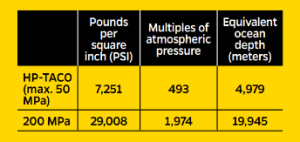‘TACO ’bo ut High Pressure’
ut High Pressure’
Many at the Hopkins Extreme Materials Institute look toward the skies to understand forces affecting asteroids and spacecraft. Others focus their attention deep underground.
Understanding sand and rock behavior at high pressure enables scientists to create safer structures, predict responses to planetary impacts, and store CO2.
Scientists can’t peer directly into the high-pressure environment of the Earth’s crust, but the High-Pressure TriAxial COmpression Instrument, or “HP-TACO,” can help.
Developed by Ryan Hurley, HEMI fellow and associate professor of mechanical engineering, HP-TACO applies confining pressures of up to 50 megapascals to sands and rocks and compresses them to failure.
“Not only can we emulate the stress states that geomaterials experience within the earth,” says Hurley, “but we can do so while using X-rays to image them in 3D.”
Hurley’s group members have already used HP-TACO to challenge assumptions about sand’s behavior under pressure, and they aim to increase HP-TACO’s capabilities to 200 megapascals—almost double the pressure at the bottom of the Mariana Trench in the North Pacific Ocean.





